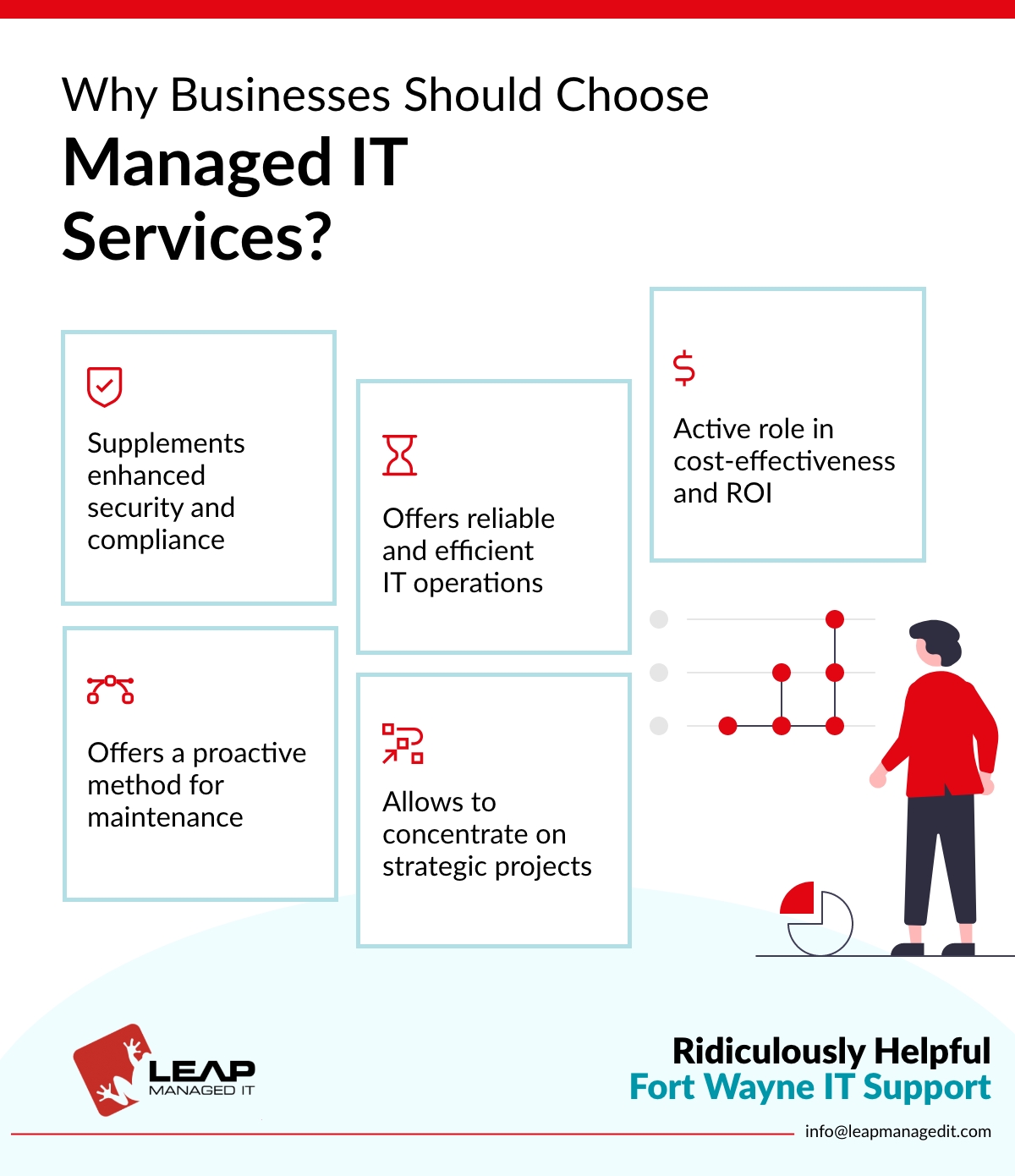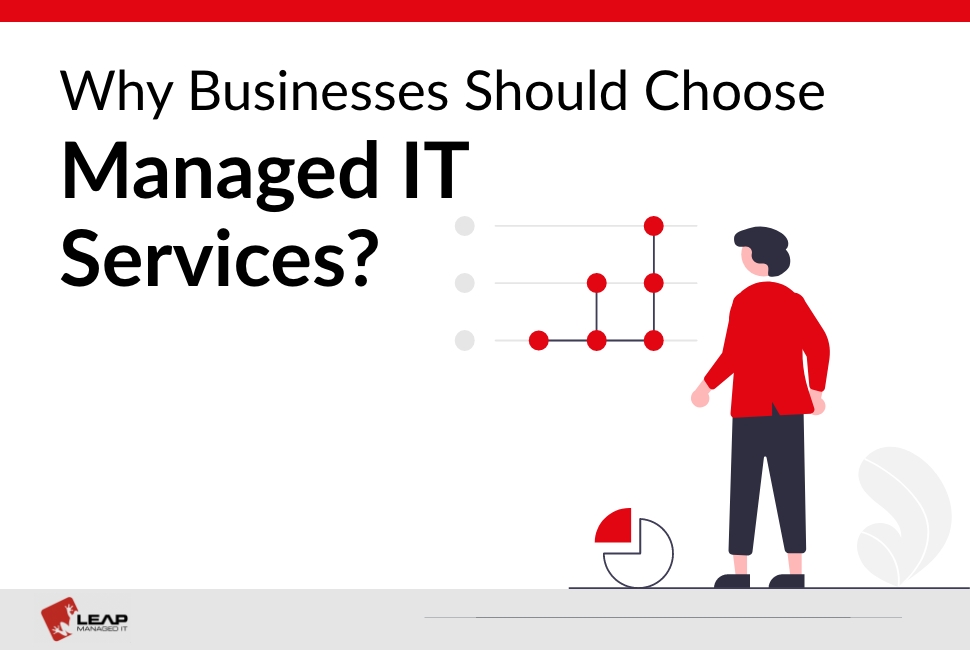What are Managed IT Services?
Managed services are any tasks performed by third-parties that are often associated with business IT services. Managed services are a way to outsource common tasks to professionals to reduce costs, improve quality of service, and free up internal teams for company-specific tasks. Namely, the companies that provide these services are called managed service providers (MSPs).
In this article, we, Indianapolis LEAP Managed IT will be sharing some crucial information about “Managed IT Services” as it would help you to consider it when your business needs it.
How is Managed IT Compared to Outsourced Services?
| Managed IT Services | Outsourced Services |
|---|---|
|
|
|
|
|
|

What Does Managed IT Include?
Cloud Managed Services
Cloud managed services are either partial or complete management of the client’s cloud platform that includes migration, optimization, and maintenance. The managed cloud service provider, enterprises can ensure that their cloud resources are running efficiently. By outsourcing this service, organizations can also avoid hiring and training costs.
The cloud managed services provide private, public, hybrid environments and also offer collaborative processes. The user’s application and data is evaluated, to determine the best cloud resources for the user’s IT infrastructure. This service includes, engineering on demand, operation management, 24/7 help desk support, hosting, and implementation. Its objective is to free-up the internal resources so that they can concentrate on other complex initiatives and new business results.
Automation
Automating the IT services tasks helps in overcoming the challenges of cost reduction, system organization and time management. It is the process of automating IT-tasks addressing operational requirements and business conditions. The process streamlines workflow, reduces manual tasks, and eliminates expensive delays.
Some key functions of the automated managed services are,
- RMM (Remote Monitoring and Management) – This enables tracking of predictive alerts and performance reviews. This tool creates an awareness of the issue with the infrastructure that is monitored.
- PSA (Professional Service Automation) – The tool is used to automate administrative tasks, customer account management, and monitor billing. This would allow the managed service provider to focus on the services offering.
Managed Cyber Security
Managed cyber security is where an organization hires a third-party service provider to manage and monitor its cybersecurity. Additionally, it includes tasks like penetration testing, risk assessment, and vulnerability scanning. Here the client is frequently updated on the latest threats and vulnerabilities along with 24/7 monitoring services.
One of the primary advantages of managed cyber security is that the provider takes the responsibility for your cybersecurity. This eliminates the need for an internal staff to manage the company’s risk. Henceforth, instead of constantly updating the company’s security systems, it can concentrate on other vital business tasks.
Contingency Planning
Contingency planning is the business community plan that consists of actions on how to continue to operate a firm following an interruption. The disruption could be the loss of the owner or a major client. The principal goal of the contingency plan is to keep the firm running in any unexpected situation.
Disaster Recovery
A disaster recovery plan is all about how to get a business back after a disaster. The disaster recovery plan is a formal document issued by a company that gives instructions on how to respond to unexpected crises. For example, crises could be natural disasters, power outages, cyber attacks, and other disruptive events.
Moreover, the plan includes techniques for mitigating the consequences of a disaster and assisting an organization in fast resuming critical activities or operating as if there had been no disruption. Disruptions can result in lost income, harmed brands, and disgruntled consumers. The larger the possible negative business impact, the longer the recovery time. A good DRP permits speedy recovery from disturbances, regardless of their cause.
When Do You Need a Managed IT provider?
Outsourcing your IT services is an excellent approach to bridge the IT skills gap that many firms are facing today. Managed service providers have emerged as the preferred IT approach for organizations of all sizes. They provide enhanced support, security, and preventative maintenance that most businesses cannot afford in-house.
When Your Organization Becomes a Victim of Cyber Attacks
If your organization is a victim of any malware, ransomware, phishing attacks and more. Suppose, your internal security team is facing difficulty in handling the situation. Hence, you would need the help of a manage service provider to handle and overcome these situations.
Not Focusing on the Technical Advancements
If you are not concentrating on the technology advancements, similarly, if you are not up to the speed of the growth in the technology. Henceforth, you would fall behind, which would be a disaster for your organization.
Here, managed IT services can help in tackling this situation as they are well-experienced and are also exposed to the latest real-world IT problems and solutions.
Additionally, managed IT services invest in education, training and tools to serve the clients. This responsibility makes them comprehensible for keeping up with the latest technology advancements.
During Migrations
Migration is quite a daunting task and when done incorrectly, would result in data loss, security breaches and extensive downtime. An expert managed IT service provider can help in completing the migration process safely and efficiently. Moreover, they analyze your current system and create migration strategies suiting your business.
Excessive Downtime
Downtime is something that every business wants to avoid. Indeed, most of them face it and at times find it to be challenging to handle the downtime.
Hence, the managed service provider can assist you in achieving this standard.
When You Need a Help Desk Support
Businesses always have an opinion that having dedicated support would help in increased productivity. Thus, the managed service provider can help you with a dedicated help desk as they are available 24/7 and also capable of offering excellent user support.
Lack of Monitoring
With a regular routine of monitoring and maintenance, you can easily prevent the occurrence of cyber threats and data breaches. Henceforth, outsourcing an expert managed IT services can help in detecting the flaws and possible risks before they become significant. It also helps in establishing the current state of your system’s health.
When You Are Out of Compliance
If you are from the industry that demands regulatory compliance, ensure to adhere to the below regulations along with IT requirements.
- HIPAA (Health Insurance Portability and Accountability Act)
- GDPR (General Data Protection Regulation)
- GLBA (Gramm-Leach-Bliley Act)
- SOX (Sarbanes Oxley Act)
- PIPEDA (Personal Information Protection and Electronic Documents Act)
- CCPA (California Consumer Privacy Act)
Further, outsourcing a qualified managed service provider, specializing in compliance would bring in great results. This would minimize risks associated with violating rules regarding credit card numbers, client data, competitive information, and more.
To Implement Security Policies
Enforcing security policies is important to ensure that the data is secure as the technology is becoming sophisticated every day. Thus, outsourcing cybersecurity experts will help in frequently updating the security policies and protect both your systems and employees.
Benefits of Managed IT Services
In reality, the organization’s internal IT team is reactive but not proactive. As a result, organizations find it difficult to keep up with the demands of the growing business. Now, it is time to consider the idea of outsourcing a third-party service as it can bring in the following benefits to your organization,
- Helps employees to focus on the core objectives
- Moreover, businesses can hire the entire IT team at a flat monthly rate
- Maintains a strategic relationship with your solutions for additional savings
- Helps businesses to shift from capital expense model to operational expense model
- Managed It services are smart enough to respond to demand in real-time hence, it can easily handle downtime
- Provides expert backup and disaster recovery plan to bring your business back online
- MSPs are 24/7/365 available
- Partners with your legal team to verify whether the maintenance security and compliance regulations
Time to Consider Managed IT Services
To conclude, we would suggest you consider the most suitable managed IT service provider for your business as they can be the all-rounders for your IT department. This would also allow your business to focus on its core objectives, keeping its growth inclined.
Are you looking for expert guidance on managed services to establish an outstanding performance in your IT department? Visit our website, LEAP Managed IT. We can help you with the best solutions by understanding your needs and business.
Also, we handle Managed I.T, Phone, Process Automation and more. Like us on Facebook and get more tips for your business.
To know more about LEAP Managed IT checkout the below video,


